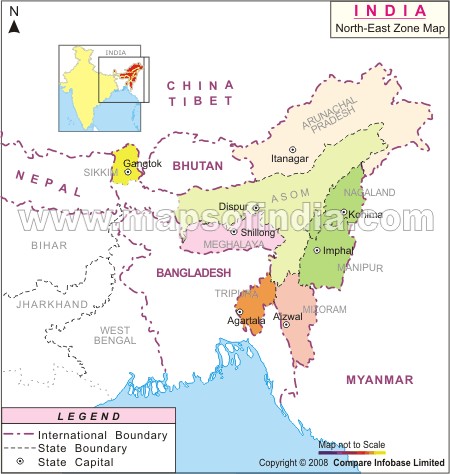Problem of workers in north-east can not be separated from the problems of North - East states.
N-E states suffer from followings :
Geographical
Difficult terrain, wide variations in slopes and altitude
Depletion of forests, degradation and erosion of soil, loss of bio-diversity, silting and raising of riverbed, increase in flood frequency and seismic prone environment. North East India is vulnerable to number of disasters. It is in highest Seismic Zone,Brahmaputra valley is prone to flood, landslide/flashflood is common to the whole region. Agricultural sector (land-man ratio = .66ha, National average = .32ha) Rain fed and mono cropped agricultural land Wide spread jhum cultivation due to lack of transport, storage and marketing infrastructures Dearth of location specific and system based technology, and no use of high yielding variety seeds, fertilizer and irrigation in most part of the regions. Unexplored rich mineral, plant and vegetable resources
Infrastructure in education, health care and communication systems
- Poor infrastructure facilities like transport, communication, input supply, marketing, credit and extension services;
- Lack of scope for higher education in different specialized fields.
Culture- Crisis of tribal identity
- Apprehending loss of traditional livelihood
- Apprehending loss of inherited skills
- Difficulty in adoption of modern technology
- Rural workers felt crisis in following urban culture as their own culture is assumed to be at stake.
Health
- Rural
Although tribesmen live close to nature, invariably their health and physique are poor. They suffer from various diseases such as malaria, yaws, tuberculosis, small pox, and venereal diseases and skin and eye diseases. In the main, to a large extent these are due to lack of clean drinking water, nutritive food, and of protection against extremes of climate. - Urban
Drug addiction and HIV
Easy access to narcotic drugs
Freedom in sexual relations
Organized sector does not absorb more labour force like past resulting sizable increase of unemployed labour force.
- Reduce unit cost of production
- Improve quality of products
- Augment purchasing power of consumers
- Improving skill of labour force through education and training.
- Development of labour intensive sectors- agriculture and allied services, food processing, rural non-farm sector like khadi and village industries, service sectors like health, education, information technology and communication,
Work Culture
- Discipline life
- Punctuality
- Cleanliness
- Quality consciousness
- Honesty
- Work as worship
Facilitating Inherited Skill
- Tribesmen have considerable inherited skill and it is essential that their arts and crafts should receive encouragement and support and they should be given facilities for vocational training.
- There are large number of subsidiary industries such as bee-keeping, basket-making, sericulture, spinning and weaving, fruit preservation and the manufacture of palm-gur which can be developed. Demonstration-cum-training are useful.
http://planningcommission.nic.in/plans/planrel/fiveyr/2nd/2planch28.html
National extension Movement
- Encouragement of settled forms of agriculture in place of shifting cultivation,
improvement of agriculture, - Provision of medical and public health services,
- Improvement of communications,
- Development of arts and crafts,
- Organisation of cooperatives
- Establishment of community welfare centres.
Such centres are a valuable method for developing local participation and leadership and are specially suited for associating the best type of local workers as well as others from more advanced areas.
PopulationMultilingualismCulture difference between plain and hill areasMis link between education and economyVery high unorganized labour force


